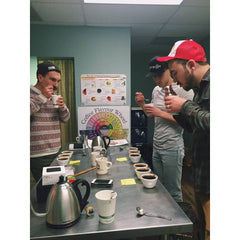Taste, Flavor and Aroma
Aug 31, 2017

If you enjoy coffee, I highly recommend attending a cupping session to explore the various ways terroir and processing can impact the flavor profile of your cup. We cup pretty non-stop at the roasting lab. It is ground zero for our quality control. We hope to start regular cup pings at the Dover Cafe. So, you might be sitting there thinking, "what the heck is a coffee cupping?"
Coffee cupping has its roots in the coffee trade of the late 19th century. Coffee traders needed a fast way to evaluate the quality of a large number of coffee lots. Back then it was a simple matter of pass/fail. Hundreds of coffee would be lined up on a table to be slurped quickly and it was thumbs up, thumbs down. Needless to say there was very little attention paid to intricacies of the coffee's flavor.
As the 20th century progressed there became an increased interest on the subtleties of a coffee's flavor. In 1932, Ukers book, All ABout Coffee, was the first to detail a notion of the cupping ritual. Back then the coffee industry was limited to describing coffee in 17 descriptors and most were extremely basic: smooth, rich, acidy, mellow, Rio-y, musty, grassy, hidey and of course, my personal favorite- rank. The dawn of the Specialty Coffee movement in 1970, coffee cuppers began taking their inspiration from wine tasters and a coffee lexicon began to form. A language of coffee was building. Cuppers took note of a nuanced sensory experience of sampling coffee flavors.
In 1995, Ted Lingle (SCAA) wrote what is now considered the canonical text of the coffee cupping industry, The Coffee Cupper's Handbook . In this book a standardized cupping procedure is put forth and has become common practice throughout the industry. At the same time, Professor Ann Noble of UC Davis developed "The Coffee Taster's Flavor Wheel. It was derived from the Wine Taster's Flavor Wheel. There are over 850 aromatic and flavor compounds in coffee; wine has approximately 200. (WE WIN!!!!)
The innate characteristics of green coffee are the volatile aromatic oils locked within the cellular structure. It is these aromatic oils which are the core of any fine coffee's unique expression. In general terms, flavor, body, acidity create the specific taste profile for each lot of coffee. The roast will then work to highlight the latent aromas that are buried within the taste.
ON TASTE
When you attend a cupping session, you should freely explore the various taste and aroma associations that the components of a coffee elicit from your life experience. The first thing I do at a cupping table is catalog, catalog, catalog! Starting with the fragrance, I associate it to a past experience and then from there, I find the best place to catalog what I am sensing. To get you started, the Specialty Coffee Association of America (SCAA) has proposed generic templates of some of the most common associations that tend to be elicited by coffees. The tree diagram below is the SCAA’s initial breakdown of the sensation that we call taste.
The spectrum of tastes given in the table is hardly an exhaustive one. If you attend a cupping session, don’t think of this particular list as a “limitation” on what you should be tasting. Instead, merely think of it as a starting point. There are bound to be other associations that the flavors in particular coffees will elicit in you: licorice, honeysuckle, bergamot, saffron, and peppermint and in my case, I always seem to get Fruity Pebbles!The high sweet notes that makes a coffee dance on the surface of your tongue, and the sweetness that sparkles on your tongue are attributes of acidity. The “body” of a coffee is also called its “mouth feel.” Body refers to the sense of richness and heaviness that is left near the back of your tongue after you taste the coffee. Sometimes it is easy to think of it as orange juice (acidity) and milk (body).The concept of “aftertaste” is one that captures the sensations of the brewed coffee vapors. Aftertastes may be described as carbony, chocolaty, spicy, or turpeny, just to name just a few.
Coffees taste is perceived mostly on the tongue by the taste buds.
SWEET- The first sensation humans develop, our appetite for sweetness is unparalleled. In coffee, a number of sugars (usually called polysaccharides or carbohydrates) exist and are perceived as sweetness. Sweetness in coffee is directly related to the ripeness of the coffee cherry when picked.
SOUR- We perceive acid on the tongue as the flavor sour. The term sour in coffee is related to an excess of acetic acid or tartaric acid due to an overfermentation or unripe coffee. However, our sour receptors also perceive desirable acidity characteristics of fine coffees.
SALTY- Frequently in coffee tasting a phantom saltiness can appear which is unrelated to mineral content. Salty flavor is a taste defect in coffee and is usually related to mineral contamination during processing, especially drying coffee on the ground.
BITTER- Our perception of bitter is thought to be an evolutionary development against environmental poisons. A common alkaloid in coffee is caffeine. Bitterness is essential to coffee's flavor and not just caffeine but other various products of sugar browning.
SAVORY- In the early 1900s, a Japanese Scientist established the taste sensation of umami (literally: deliciousness) by isolating the flavorful component of kombu seaweed. The isolated active component was glutamic acid. Glutamic acid is the most common amino acid in food protein. Savoriness in coffee is thought to be related to yeast activity during fermentation phase of processing.
ON AROMA
The “aroma” of a coffee should be considered in juxtaposition to its acidity and flavor. Floral notes in coffees may sometimes only be experienced within the context of the aroma. A distinct fresh floral note can easily be distinguished in the aroma.The SCAA has also put forward a breakdown of coffee aromas. Since there are so many more aromas than tastes, the SCAA aroma breakdowns require four charts to list them all.
The SCAA has separated aroma into three generic categories: Enzymatic; Sugar Browning; and Dry Distillation. These basic categories are broken down further in the tree diagrams below. Again, this set of categorizations should not be used to limit what you experience when you savor the aroma of a coffee. Instead, use them as a starting point in forming your own associations.
ENZYMATIC BY PRODUCTS- are related to enzymes reactions in the plant itself and enzymatic reactions during processing.
SUGAR BROWNING- as the name implies are aromatic compounds during the roasting process by thermal reactions in sugar browning, called Maillard Reactions. These include caramelly, nutty, toastlike and grain aromas.
DRY DISTILLATION BY PRODUCTS- are related to the burning of plant fibers during roasting. Spicy, smoky and woody aromas are in this group.
To bring it all home, coffee's flavor is a combination of its taste perceived on the tongue, and a myriad of aromatics perceived in the nasal cavity. The more you cup, the more skilled you become in the art of tasting in general and of articulating this experience specifically.



